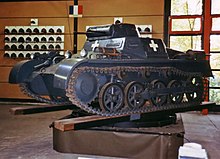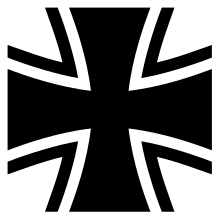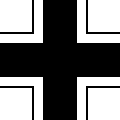Black cross (symbol)
The Black Cross is a national emblem that was used by the Prussian and German armed forces and is used as an order cross by the Teutonic Order . The Bundeswehr still uses it today as a stylized paw cross . The Archbishopric and Electorate of Cologne, as well as various cities in its territory, have a black cross on a white background in coats of arms and flags, e.g. B. Bonn , Kaiserswerth , Rheinbach and Rhens .
History of the national emblem

The German Order since its inception in 1190 uses a black cross on a white background to delineate and distinguish them from the other military orders that had already crosses in other colors. The meaning of the cross goes back to the cross of Christ and should show that the order is of Christian character.
Original form
The original form used by the Teutonic Order appeared in the variants black paw cross or black Latin cross on a white background. These representations resembled the signs of other knightly orders, in particular that of the Knights Templar .
19th century
At the beginning of the Wars of Liberation in 1813, the black cross on a white background was adopted by Prussia as a war decoration and symbol. From then on it adorned the Prussian war flag next to the black eagle . The war award was given the name " Iron Cross " because it was made of iron. From now on, this designation was also used for the national emblem. The proposal and design came from King Friedrich Wilhelm III. , the draft of Karl Friedrich Schinkel .
With the establishment of the German Empire and the Imperial Navy in 1871, the Iron Cross appeared in the war flag , as it had previously been awarded to non-Prussian soldiers of the North German Confederation . From 1916 to 1918 it was used in its simplified form as a bar cross. Later, both the Reichswehr and the Wehrmacht adopted the symbol in its various forms as a national emblem.
20th century
On October 1, 1956, Federal President Theodor Heuss ordered the black cross in the shape of a paw to identify the "aircraft and combat vehicles of the Bundeswehr" .
Embodiments of the Iron Cross as a national emblem
In the course of the use of the cross, it was repeatedly changed in its design.
Iron Cross
In the Reichsmarine and from the First World War on the aircraft of the air force , the iron cross was executed as a paw cross with a white border or on a white background. This form was used on the aircraft of the air force until around 1916. This shape has remained on the flags of the Navy since that time.
The Bundeswehr went back to this form, but the white border is limited to the inner edges of the cross in the Bundeswehr.
Marine shape
On the flags of the Navy, the cross is often made with narrower bars.
White cross

At the beginning of the Second World War , the German tanks carried a white cross on all sides as an identification mark. However, it was already apparent during the attack on Poland that these conspicuous signs were used by the opposing anti-tank defense as a sighting aid. (The same experience with a conspicuous marking later made the US troops with the white star, which served as a recognition symbol for their tanks.) To counter this problem, a black cross was placed in the white after the attack on Poland, whereby only one a narrow white border in the form of four angles remained - the bar cross.
Balkenkreuz
The Balkenkreuz was used by the air force and tank troops of the German Reich from around 1916. It was a simple cross in white or black with a border around the inside edges of the cross. In the Wehrmacht, this shape of the cross was also used without interior paint, with only the border being painted.
Individual evidence
- ↑ a b c Federal Ministry of Defense The Iron Cross November 11, 2011
- ↑ B PresKennzAnO
- ^ A b Adolf Schlicht, John R. Angolia: The German Wehrmacht. Uniforms and equipment. 1933-1945. Volume 1: The Army. 4th edition. Motorbuch-Verlag, Stuttgart 2000, ISBN 3-613-01390-8 , p. 581.





